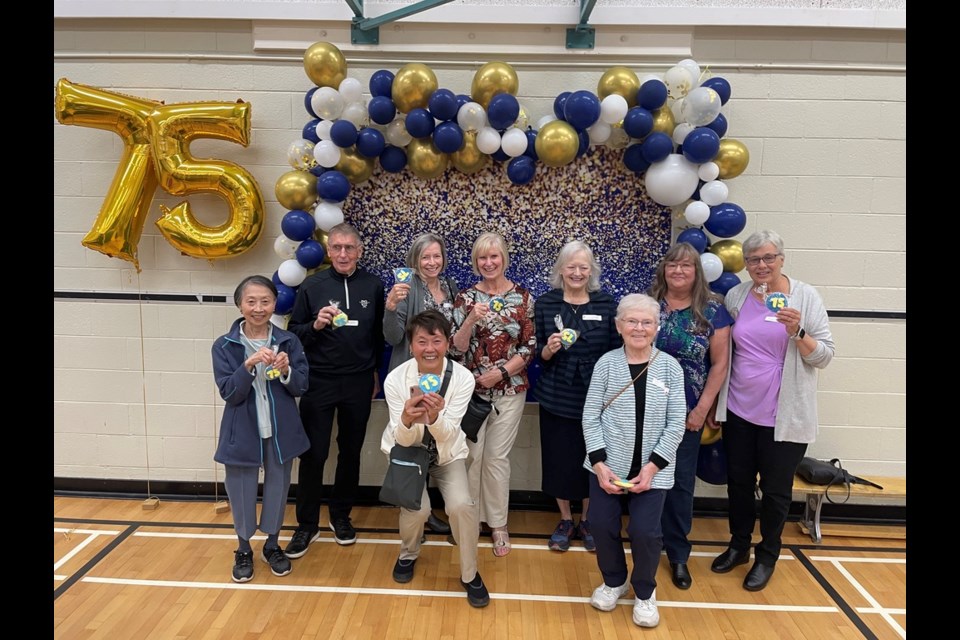Almost 300 alumni, students and staff from past and present gathered at a Richmond school on May 30 to celebrate a monumental moment — the 75th year since its establishment.
"(We) just saw such joy when people came in," said May Wong, principal of Garden City elementary.
"It was community. ... It was just community in its true sense. Nothing online and social media could ever mimic that ability, that social connection, (that) human connection between people."
Attendees were grouped according to eras from the 1940s to the present day and asked to bring mementos from their time at the school to share with the rest of the community.
"So people came either by themselves ... looking for a long-lost friend, or people were sitting there waiting to see their teacher," said Wong.
"There were people who went to school at Garden City in the '60s, and some in the late '50s, and they probably weren't in the same class. But they were able to connect and they left together. And it's almost like they found a friend."
Garden City elementary, built in 1949 in the post-war era, is one of the few Richmond schools not named after a person.
"After the war, there was a boom of people having children... and there was a lack of schools in Richmond," Wong explained.
She added Garden City is a "cookie cutter school" and a twin to Grauer elementary. The two schools opened at the same time and shared identical building structures, though Garden City has since shifted its entrance to be closer to the main road.
The school was split into boys' and girls' sides, and much like the rest of the city, was surrounded by ditches.
Now, the original structure serves as the middle section of the school. A gym was added around 1956, and in the 1970s, the school got a back hallway with extra classrooms.
Celebrating community
One goal of the big celebration was to celebrate the school's past, Wong told the Richmond News.
"(It's important) to acknowledge the past, because the present doesn't exist... unless there was a past. That's your foundation. And I found that senior alumni gave so much to society and gave so much... to our present day," she explained.
"And I think it was a celebration to acknowledge their contributions."
The organizers also wanted to provide an opportunity for the community to come together to make up for the feelings of isolation everyone experienced during the COVID-19 pandemic.
Seeing the success of the event, Wong was thankful to all attendees and school staff who went the extra mile to make the event happen.
"This shows the care of the community... It gives a lot of faith in that there are people that really care about community," said Wong.
"And that's comforting for a lot of people, seeing that everyone had kind of gone into silos during the pandemic and (we tried) to bring people out to build community.
Looking back at stories from the past
Preparation for the event involved a little sleuthing on Wong's part, who dug through the school's attic and visited General Currie School's heritage museum to uncover pieces of the school's history. She also consulted interviews conducted by the Richmond Nature Park and writings by Thomas Kidd and other Richmond icons.
"It was really nice for me to learn a little bit about the history of the school and connect with different people," she said.
"You kind of piece things together — the nature of the school, how the school came to be and what was happening in the world, in Richmond during that time."
It was important to keep such pieces of history alive, Wong explained, because they give Richmondites a glimpse into what the population was like back then and to better understand the land we reside on.
"Those things all came through when you hear the stories of the students and the teachers that walked down these hallways," said Wong.
Students were shifted "from place to place" back then while schools were still being built, she said, adding that some schools worked in shifts. For example, students from McRoberts secondary would use a school building in the morning, and Palmer secondary students would take over in the afternoon.
Students back then were also "really good at jumping ditches," Wong told the News.
"There were a lot of ditches that were the size of a car. And a lot of the stories (were) people needing to leap over these, get really good at it and then they (would) have to go home and explain to their parents why they were wet."
But some things still stayed the same.
"There were people that came (who were at the school in) 1949... They hid in the same places where the kids (hide) today, funny enough," said Wong.
"They were playing jacks and they didn't want to get caught to go outside. (And) we would have kids (now) that hide in the same corner, not wanting to go outside because it's raining."
Now that the celebration has wrapped up successfully, Wong hopes to create an archive of all such stories starting with memories written down by attendees at the celebration.
"I felt because everything is digital and this group of cohort... their stories will be lost," she explained, adding that many milestones at the school were not fully documented.
"I just feared that all that precious information (would) be lost, or memories will be lost. And people are moving away from Richmond in terms of affordability, so those stories (will) become harder and harder to come by."
Got an opinion on this story or any others in Richmond? Send us a letter or email your thoughts or story tips to [email protected]. To stay updated on Richmond news, sign up for our daily headline newsletter.



